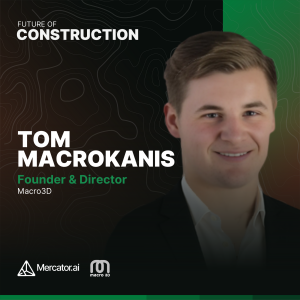

Macro3D’s Tom Macrokanis on Managing Financial Risk When Introducing Building Tech
Construction 3D printing is positioned to revolutionize how we build, but the path to mass adoption is paved with regulatory hurdles and financial challenges. In this episode of The Future of Construction, Tom Macrokanis, Founder & Director of Macro3D, shares his journey from software developer to pioneering 3D concrete printing in Australia.
Tom tells Chloe how he created a profitable steel fabrication business specifically to fund his printing technology, the challenges of convincing skeptical builders that 3D printed walls function like double brick construction, and his data-driven approach to quality assurance — tracking every material property throughout the printing process.
Despite battling constrained investment environments and construction payment terms that leave "hundreds of thousands in unpaid invoices," Tom remains committed to solving Australia's housing shortage through faster construction methods that require fewer workers.
Topics discussed:
- How to implement a dual company funding model for hardware innovation when traditional VCs won't invest, creating a profitable service business (steel fabrication) with immediate revenue to systematically fund long-term R&D for revolutionary construction technology.
- Navigating regulatory frameworks with the building code parallel mapping strategy that identifies existing approved construction methods with structural similarities to new technology, creating certification pathways by demonstrating functional equivalence to established methods like double brick construction.
- Why speed-to-market trumps cost advantage in early-stage construction innovation, for examples focusing on reducing build time by 30-40% while maintaining industry-standard pricing around $300/sqm, rather than immediately passing all potential cost efficiencies to customers.
- Implementing a triple stakeholder education protocol that simultaneously engages builders, inspectors, and engineers in collaborative learning sessions, transforming potential blockers into innovation partners through hands-on demonstration and participatory problem-solving.
- Leveraging comprehensive data collection as a competitive moat by tracking material properties and environmental conditions for every layer of concrete, providing verifiable quality documentation impossible with traditional "spot testing" methods that only sample occasional concrete batches.
- Mitigating cash flow challenges through strategic deposit structuring: securing 75% upfront payment (50% initial deposit, 25% pre-site delivery) from innovation-friendly clients to fund development while navigating construction's traditional progress payment schedules.
- Identifying a synergy and patience client profile in construction innovation, targeting early adopters who recognize startup constraints, accommodate inevitable technology refinements, and view collaboration as strategic investment rather than traditional vendor relationship.
More Episodes
All Episodes>>Create Your Podcast In Minutes
- Full-featured podcast site
- Unlimited storage and bandwidth
- Comprehensive podcast stats
- Distribute to Apple Podcasts, Spotify, and more
- Make money with your podcast












